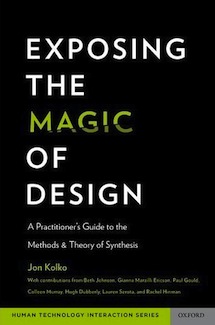In the last few years, American business has latched onto innovation as the goal of nearly all product development efforts. If we are to believe the business journals and popular magazines, innovation will be the single savior of all things outsourced, offshored, or commoditized.
In the last few years, American business has latched onto innovation as the goal of nearly all product development efforts. If we are to believe the business journals and popular magazines, innovation will be the single savior of all things outsourced, offshored, or commoditized.
Simultaneously, and not necessarily as a separate conversation, behavior change in developing countries has become a common point of discussion amongst leaders in the Global 2000. Many leading businesses are driven by both good intentions and financial motivations, and we frequently reference the bottom of the pyramid—the large population of poor in developing countries—as a primary target of our creative efforts. Consequently, many of us now find ourselves at the center of an evolving discourse: of designing with instead of designing for, where creative efforts are rewarded as both profitable and instrumental for the success of humanity in developing countries.
It’s hard to ignore this hype and hyperbole, and for younger designers just entering the profession as well as for established businesses who are discovering the power of design, design feels truly magical.
But as with magic, we’re rarely satisfied to observe design passively; we want to know how the magic works, to understand the nuances of the phenomenon, and to contain and push the boundaries, removing the mystique and mystery. And in the context of business and society, with so much at stake, it’s quite sensible to expect rigor, method, and process in a discipline that many are only now beginning to view as a legitimate and thoughtful endeavor.
Yet design isn’t magic, and the tools and techniques used by experienced designers can be learned, and taught, and repeated in a methodical manner.
The Voice Between Research and Form-Giving
Many designers in the U.S. have learned a user-centered methodology that focuses on design research. This typically consists of rapid, or “discount,” anthropology in the context of a given area of study or problem focus. Through this ethnographic research, designers quickly gain both knowledge and empathy concerning a given subject from experts in that area—the people who will actually use a product, service, or system that is to be designed.
This form of applied anthropology has gained traction as one of the keys to innovation. As far back as 2006, BusinessWeek made this declaration:
Ethnography is catching fire in the corporate world. The beauty of ethnography, say its proponents, is that it provides a richer understanding of consumers than traditional research methods. Yes, companies are still using focus groups, surveys, and demographic data to glean insights into the consumer mind. But closely observing people where they live and work allows companies to zero in on customers’ unarticulated desires.
There are now established methods for observing people in the context of their work, and books such as Contextual Design and Observing the User Experience provide step-by-step resources for conducting ethnographic research.
Similarly, designers have established methods for giving form to an idea. Through ideation sketching, rapid visualization, model and prototype creation, and methods of participatory design, designers can work with and for users to bring a new idea to life. And as is the case with ethnography, there are methods, techniques, and books that outline exactly how to go about sketching, building, and prototyping software, products, systems and services.
But between research and form-giving is a void of method and technique. Research itself does not define areas of opportunity, identify themes, locate patterns, or emphasize anomalies; anthropological research simply generates a vast quantity of data. That data must be mined, translated, interpreted, and evaluated. And through this interpretation come ideas, but these ideas are not yet fully formed—they require incubation, treatment, attention and refinement.
It is in this void between research and form-giving where many designers struggle and where much time is wasted. Yet it is also in this void where the most exciting qualities of magic are most likely to be found. Between research and ideation come creative leaps, disruptive new ideas, and innovative new solutions to real and pressing problems.
In this void, design synthesis must occur.
Formalizing Design Synthesis

The second goal is to offer a rationale for why design synthesis is important, both in a general sense (“Why should I care about this at all?”) as well as in a more immediate sense (“Why should I care about this right now?”).
The final goal is to present a set of actionable, learnable methods for design synthesis that can be applied to any design problem. Practicing designers can use these methods to make sense of complicated design problems and to move seamlessly from various forms of research to design. The methods can add a systematic sense of rigor to an otherwise subjective, often introspective process.
Exposing the Magic of Design is an introduction to design synthesis for practicing designers and business owners. The text presents a framework of synthesis, borrowing heavily from research related to human behavior, cognitive psychology, and social communications theory. Within this framework, the text also presents a series of synthesis methods that can be immediately applied to both big and small design problems. Finally, more advanced applications of synthesis illustrate the potential for complicated problem solving, and for bridging the void between research and ideation.
The increasingly complex issues of sustainability, finance, culture, technology, and businesses are searching for a form of problem solving that can deal with unprecedented levels of ambiguity, chaos, and data. Businesses that need a way to stay competitive in a global economy have been urged to reject standard forms of marketing and product development. The popular media has disparaged traditional “linear thinking” as inadequate for the global economic crisis. Yet little has been offered as an alternative. It is not enough to demand more innovation without providing the tools to succeed. Design synthesis is a way of thinking about complicated, multifaceted problems of this scale with a repeatable degree of success.
A Special Offer for Readers…
Oxford University Press is proud to offer readers of UX Magazine a 20% discount off Exposing the Magic of Design. Visit the Oxford University Press website to buy online, and enter promo code 29397 at checkout.




